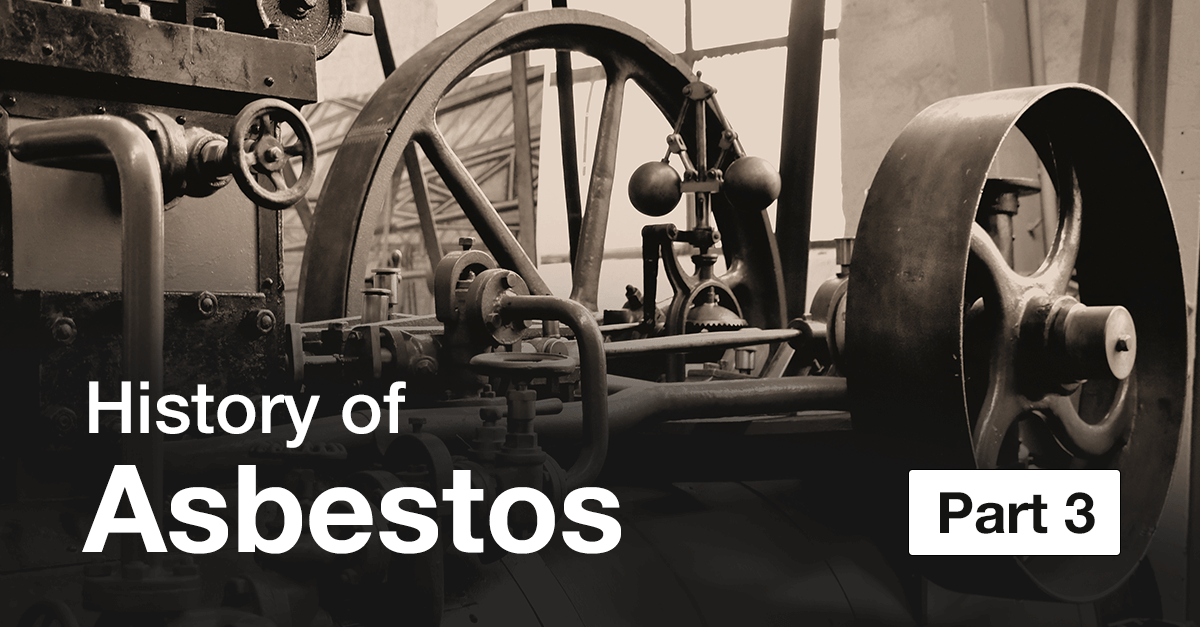
For thousands of years, asbestos remained in the margins of ancient society, bewildering onlookers with its magical fire-resistant properties while concealing its more harmful ones. But as civilization matured, so did its use of asbestos.
In our previous installments, we learned how ancient and medieval societies used this mysterious, naturally occurring mineral to protect cremated remains, clean fabrics, mystify travelers and besiege castles.
However, asbestos use reached new heights in the 19th century, when ambitious industrialists found ways to make extraordinary profits from mining the mineral and manufacturing asbestos-containing products, like insulation, roofing tiles, brake pads and cement.
This was the time of the industrial revolution, an era of unprecedented economic growth driven by a new system of labor with unrivaled access to capital. All that power, wealth and demand resulted in asbestos-containing materials being used in millions of buildings, vehicles, factories, machines and ships all over the world — as well as the lungs of millions of unlucky workers.
For decades, asbestos lurked in these spaces, threatening the health of workers and families well into the 21st century. It is during this period that we find the beginnings of a modern public health crisis.
The Birth of a Global Asbestos Industry
One of the earliest asbestos mining operations was in Thetford Hills, Quebec, a region of Canada that continued to extract this mineral until the last two mines closed in 2011.
Asbestos mines were also established in northern Italy, South Africa and the Ural mountains of Russia, which is the largest asbestos mining and exporting country in the world today.
Much of that raw asbestos was shipped to Europe and processed by the Scottish Patent Asbestos Manufacturing Company.
In the United States, asbestos processing began as early as 1858. The Johns Company, which later became known as Johns Manville, started mining fibrous anthophyllite, a type of asbestos, from a quarry on Staten Island, New York.
The company would eventually become the largest miner, processor, manufacturer and supplier of asbestos and asbestos-containing products in the world, mostly in service of insulation and construction materials.
The High Demand for a “Miracle” Mineral
With the construction boom brought on by the industrial revolution, developers sought new ways to protect their factories, office buildings and high rises from the threat of fire.
Throughout the 19th century, cities became more densely populated, and factories started handling more volatile materials. As a result, fires occurred more frequently than in previous eras.
Asbestos proved highly effective at keeping fires at bay, and by the 1870s, asbestos companies started popping up everywhere to provide builders with a steady supply.
The incredible demand for asbestos was driven by its many applications, including in:
- Bricks
- Concrete
- Fireproof drywall
- Fire-retardant coatings
- Heat-resistant gaskets
- Joint compound
- Paint
- Pipe insulation
Even less suspecting products like lawn furniture were manufactured with asbestos at some point during this time.
To meet the demand, new U.S. mines were established in Vermont, Georgia, Montana, California and all throughout Appalachia.
With millions of tons of asbestos being extracted from the earth and put into buildings, it’s no wonder the U.S. Environmental Protection Agency (EPA) estimated 20% of all buildings contained asbestos in some form or another in 1985.
An Asbestos Omen in Montana
One of the most catastrophic asbestos mining operations in history occurred in Libby, Montana. In 1881, gold miners in Libby discovered vermiculite — a valuable mineral used for insulation and soil conditioning.
Vermiculite, however, is often contaminated with asbestos, as the two minerals form through the same geologic processes. To this day, vermiculite mines are frequently tested for the presence of asbestos.
While in operation, the Libby mine may have produced 80% of the world’s supply of vermiculite, and almost all of it was contaminated with asbestos, according to the EPA.
Over the course of its operations, the Libby mine exposed around 100,000 local residents to asbestos, killing hundreds and leaving thousands sick. It remained open with workers mining the asbestos-contaminated vermiculite until 1990.
Federal prosecutors would later sue the mine owner, W.R. Grace, alleging the company was aware of the asbestos contamination and decided to continue operations anyway.
Simply put, the company knew asbestos was dangerous and chose not to warn workers, putting profits before the health and safety of their employees. Unfortunately, that narrative would become familiar as more and more asbestos lawsuits shed light on these companies’ wrongdoing.
A Health Crisis Emerges
At the turn of the 20th century, medical research continued to advance and revealed an alarming truth about the lingering health effects of asbestos — those who worked with the mineral were dying at unusually high rates.
In 1897, a forward-thinking Austrian doctor linked the inhalation of asbestos fibers to the pulmonary problems of one of his patients.
A few years later, an English doctor at London’s Charing Cross Hospital named Montague Murray discovered a number of deaths in patients who had worked spinning asbestos. All 10 of them were in their 30s and previously healthy.
They all presented with the same symptoms before passing away:
- Bloody cough
- Chest pain
- Shortness of breath
Dr. Murray performed an autopsy on one patient and discovered heavy scarring in the lungs, but it would still be decades before the wider medical community understood what they were dealing with.
Asbestosis — the disease that killed English worker Nellie Kershaw — wasn’t described until the early 1930s. Kershaw had worked at a textile factory called Turner Brothers Asbestos Company for roughly 15 years.
Mesothelioma, a deadly form of cancer caused by inhaling asbestos fibers, wasn’t connected to asbestos until the 1940s.
To further complicate doctors’ abilities to connect asbestos and these illnesses, it can take decades after exposure for symptoms to first develop.
Labor Movements Take Small Steps Toward Protection
While the research on the health effects was slow, the labor movements of the late 19th and early 20th century delivered a small victory to workers at higher risk of asbestos exposure.
In 1908, Congress passed the Federal Employers’ Liability Act (FELA) with the goal of protecting and awarding railroad workers who were injured on the job compensation for their employers’ negligence.
FELA was an early triumph in what would become a century-long battle to protect workers and hold corporate wrongdoers accountable. What the railroad workers, spinners and machinists of that era could not foresee was just how devious the asbestos industry would get in its attempts to secure profits and protect its prized mineral.
As the first lawsuits were brought against companies who mined, shipped, processed and sold asbestos, a pattern of downplaying, deflecting, misinforming and outright lying emerged. Asbestos companies, it seemed, would do or say anything to protect their profits.
In the next installment on the history of asbestos, we’ll look at how these companies profited off of the U.S. military and capitalized on war efforts throughout the 20th century.
Find Out More About the History of Asbestos
You can learn more about asbestos in each of our installments on the history of the mineral now:
- History of Asbestos, Pt. 1: Asbestos in the Ancient World
- History of Asbestos, Pt. 2: Asbestos in the Middle Ages
- History of Asbestos, Pt. 4: Asbestos From Its Heyday to the Era of Regulation
- History of Asbestos, Pt. 5: Asbestos in the Present Day
As a trusted national asbestos exposure law firm, Simmons Hanly Conroy is dedicated to helping mesothelioma patients and their families get justice.
Contact us now to learn more about your legal options for free if you or a loved one has been affected by asbestos exposure.




